
Malayan Sun Bear
Malayan Sun Bear
Malayan Sun Bear
Have you heard of the animal called 'Malayan Sun Bear'? As the name suggests, it's a type of bear, but when you think of bears, you might imagine something a bit scary. However, the Malayan Sun Bear is different from the bears you might envision, it's actually quite adorable. By the end of this article, you might find yourself wanting to meet a Malayan Sun Bear. Let's dive into learning more about them!
Malayan Sun Bear Basic Infomation
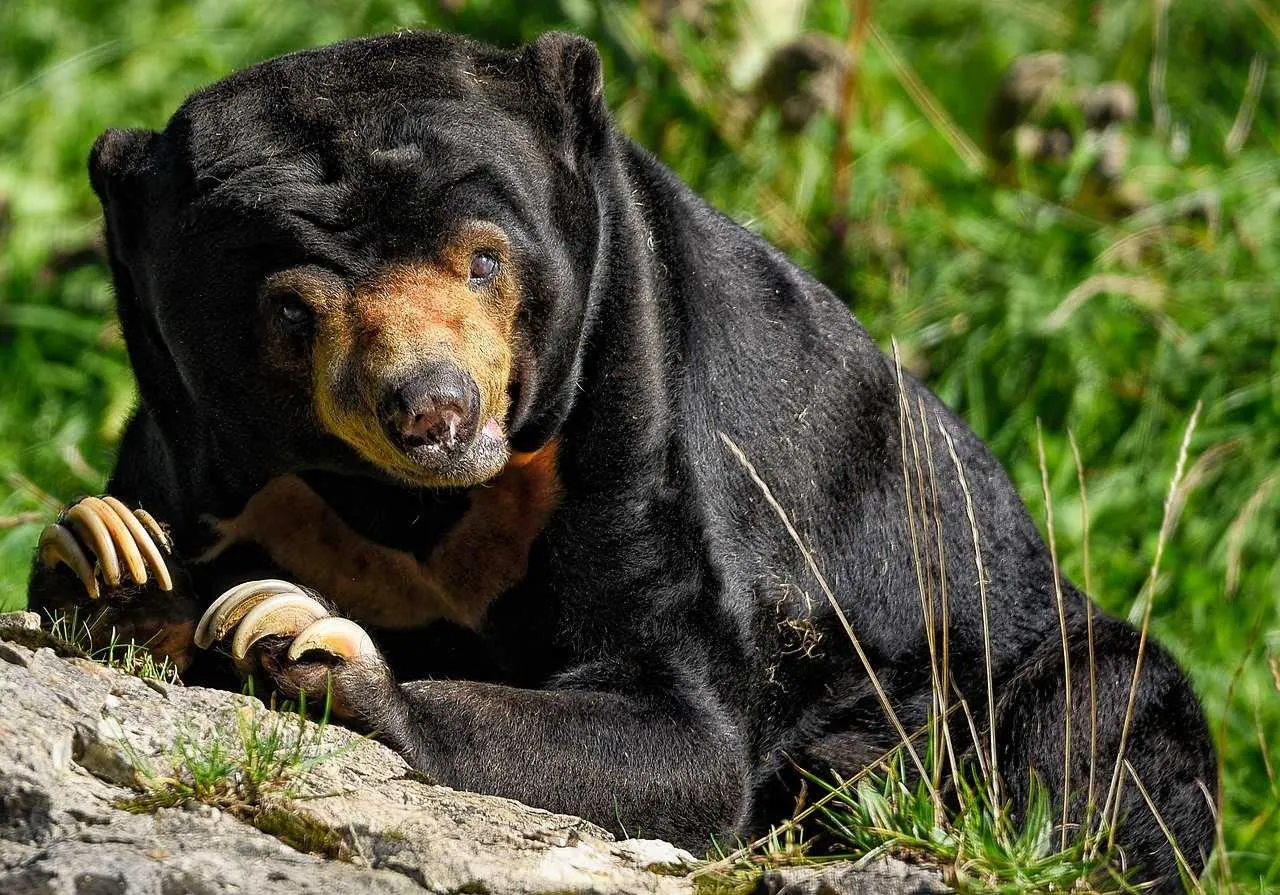
| Property | Value |
|---|---|
| Scientific Name | Helarctos malayanus |
| Taxonomic Status | ACCEPTED |
| Rank | SPECIES |
| Kingdom | Animalia |
| Phylum | Chordata |
| Class | Mammalia |
| Order | Carnivora |
| Family | Ursidae |
| Genus | Helarctos |
| Habitats | Tropical evergreen rainforests, Peat swamp forests, Montane forests |
| Descriptions | Sun bears are the smallest of the bear family and are known for their short black fur and a distinct crescent-shaped chest patch. They have exceptionally long tongues, used to extract honey and insects. They are primarily diurnal and are found in Southeast Asia. |
| Conservation Status | VULNERABLE |
| Common Names | Malayan Sun Bear, Sun Bear |
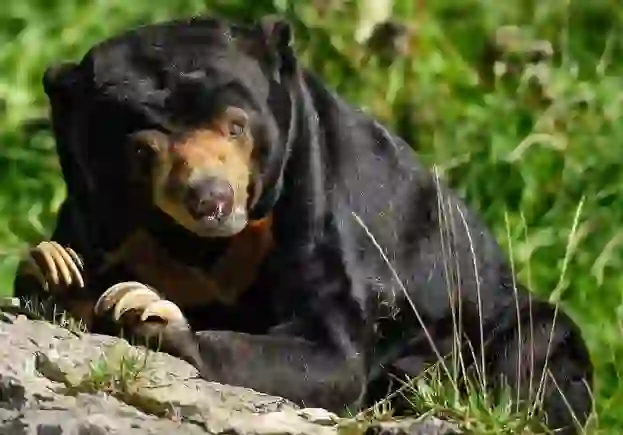
Mammalia Carnivora Ursidae Helarctos
Body length: 100 to 150 cm
Weight: 25 to 80 kg
Malayan Sun Bears live in warm regions such as northeastern India, Indonesia, Cambodia, southwestern China, Thailand, Bangladesh, Brunei, Vietnam, Malaysia, Myanmar, and Laos.
Take note of the body length and weight; they seem quite small, don't they? Malayan Sun Bears are the smallest among bears, and in human terms, they are about the height of a young elementary school child.
Their entire body is covered with short black fur, and on their chest, they have V-shaped, U-shaped, or even crescent-shaped patterns that are white or pale yellow. The shape and size of these patterns vary slightly among Malayan Sun Bears, so it's like having a favorite scarf with different shapes or sizes. Some don't have the crescent-shaped white markings, suggesting they might have decided not to wear a scarf.
They have small, rounded ears and a short nose, giving them a more adorable appearance compared to what you might expect from a bear. Their tongues are long, measuring 20 to 25 cm, which might surprise you when it extends from their cute face. Their forepaws and hind paws each have five fingers with long, sharp, and curved claws. The palms of their hands and the soles of their feet are hairless.
When walking on the ground, they have an inward gait and long, slender legs. Additionally, their forehead has wrinkles, which might make them look somewhat human-like. It's sometimes jokingly said that there might be an old man inside them.
Malayan Sun Bear Q&A

What is the origin of the name Malayan Sun Bear?
The Japanese name 'Malayan Sun Bear' comes from the fact that it is a bear living on the Malay Peninsula.
The Chinese name for the Malayan Sun Bear is also similar in origin to the Japanese name. In Chinese, it is written as '馬来熊,' which indicates a bear living in the 'Malay' region. The Chinese name '馬来' refers to the Malay Peninsula and its surrounding islands, thus the name '馬来熊' was derived from this.
Malayan Sun Bears have various names in English, including 'Dog bear,' due to their small size, suggesting they are like small dogs. Additionally, due to the bright color on their chest, they are also called 'Sun bear,' indicating a resemblance to the sun.
In Malay, they are called 'Basindo nan tenggil,' which means 'those who like to sit in high places,' referring to their habits.
In Indonesian, they are called 'Beruang Madu,' meaning 'honey bear,' because Malayan Sun Bears love to eat honey.
Their names are derived not only from the places they live but also from distinctive characteristics, behaviors, and preferred foods.
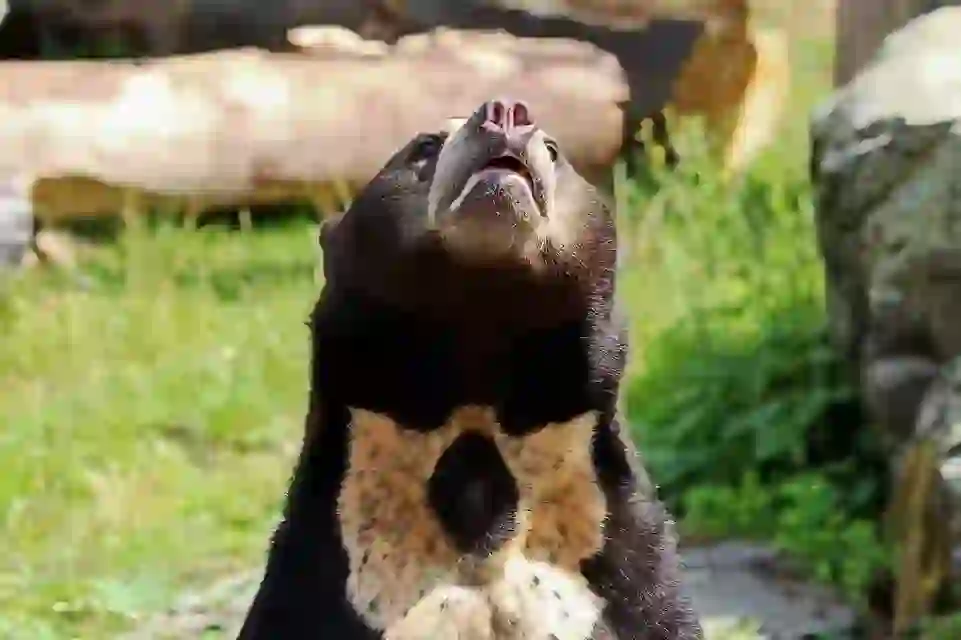
Why do Malayan Sun Bears live in those regions?
Malayan Sun Bears live in warm forests, mangroves, and forests at an altitude of 2,500 meters. The short hair and small body size are thought to be because they live in warm regions. Bears in colder areas have long hair and large bodies to protect themselves from the cold, while Malayan Sun Bears do not need to grow long hair or accumulate fat.
Since they live in warm regions, Malayan Sun Bears do not hibernate, unlike other bears, because there is always food available.
Malayan Sun Bears are mainly solitary, but mother bears and their cubs stay together. In places with abundant food, they can form groups.
Malayan Sun Bears are nocturnal, sleeping during the day and active at night. During the day, they rest by sleeping or sunbathing in the trees. Although they build nests, they are cautious animals, so Malayan Sun Bears living near people build their nests or lookout points in trees to detect approaching threats.
Malayan Sun Bears have poor eyesight but highly developed hearing and sense of smell. They rely more on hearing footsteps and sensing other signs of approaching threats.
Malayan Sun Bears are excellent climbers. Their inwardly pointing feet and long, sharp claws allow them to grip onto trees firmly, making climbing easier.
They are not only good at climbing but also skilled at digging holes, thanks to their strong forearms and long claws.
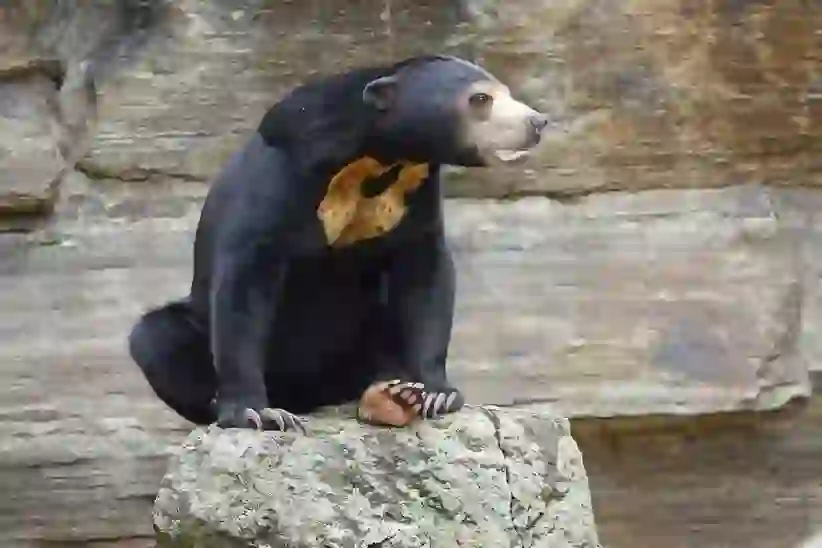
What do Malayan Sun Bears eat?
Malayan Sun Bears are omnivorous, eating fruits, tree sprouts, roots, insects, lizards, small animals, birds, and bird eggs. They are particularly fond of insects, including ants, termites, and bees, as well as honey. When picturing them eating honey, it might remind you of a famous yellow bear character, although their color is different.
Their strong jaws allow them to easily break open hard-skinned fruits, and their long tongues help extract insects from holes. They may also use their paws to break into ant and bee nests to eat the insects.
Malayan Sun Bears have excellent sense of smell, which helps them find food. Some even suggest their sense of smell is better than that of dogs.
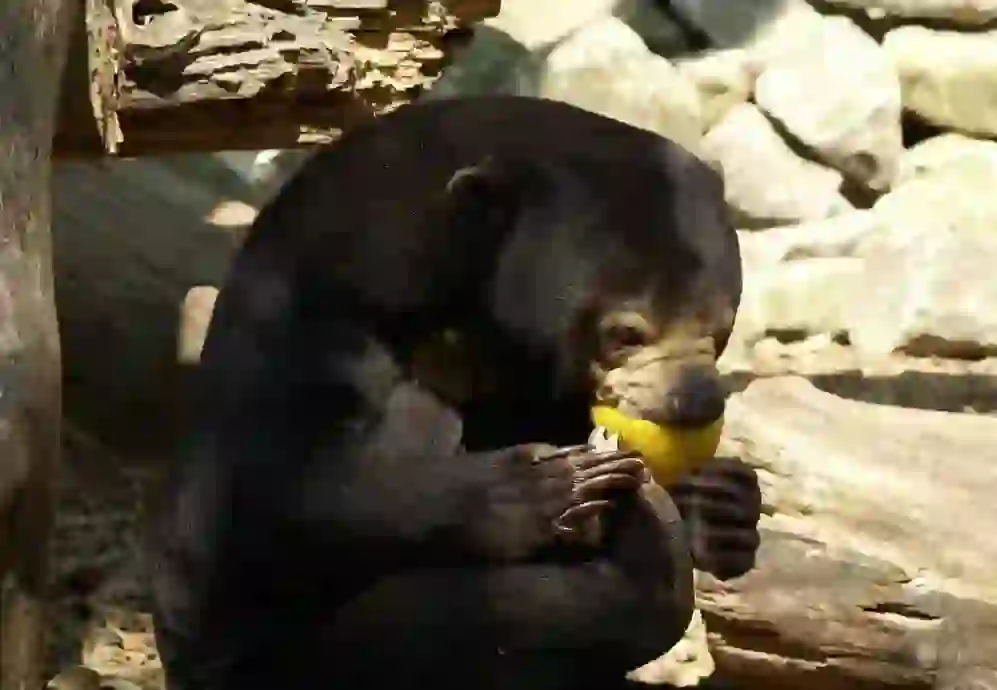
How do Malayan Sun Bears reproduce?
Malayan Sun Bears do not have a fixed breeding season; they reproduce once a year. The gestation period is between 95 and 100 days, which is much shorter than for other bears, like brown bears, which have about 240 days of gestation.
After giving birth, the mother bear feeds her cubs with milk. Newborn cubs are blind and hairless, relying on their mother to find their way. Around four weeks after birth, they open their eyes, and by seven weeks, they can see. This progression shows they are growing.
Despite the shorter gestation period, the nursing period is about 18 months, which is relatively long. Malayan Sun Bears are considered adults after about three years, but they often stay with their mothers until then.

Are Malayan Sun Bears timid?
Bears are often considered aggressive and dangerous, but Malayan Sun Bears, along with other bears, are actually quite timid. Malayan Sun Bears are considered the weakest among bears. So, why do bears have an aggressive reputation?
Bears, including Malayan Sun Bears, become aggressive to protect something. Similar to humans, who might become protective of loved ones, Malayan Sun Bears become aggressive to protect themselves or their cubs.
Malayan Sun Bears rarely attack humans unless they feel threatened. Most incidents where humans are injured by Malayan Sun Bears involve humans provoking them.
Despite being considered timid, Malayan Sun Bears have strong jaws and sharp claws, which can pose a risk. In Indonesia, there are reports of bear-related incidents each year. However, these incidents usually involve humans initiating the aggression.
While Malayan Sun Bears are not naturally aggressive, they can act aggressively when they feel threatened. Humans should respect their boundaries and learn to coexist peacefully with them.

Are Malayan Sun Bears classified as endangered?
Malayan Sun Bears are classified as endangered, listed as 'Endangered II,' indicating a growing risk of extinction. Why are their numbers declining?
Although Malayan Sun Bears have natural predators such as tigers and leopards, the main reasons for their decline are related to humans and environmental factors.
The warm climates where Malayan Sun Bears live are also attractive for humans, leading to extensive deforestation for agriculture, resulting in a loss of food sources and habitats for Malayan Sun Bears.
Deforestation isn't the only cause of their decline. Malayan Sun Bears' fur is prized for its sleek and shiny appearance, and their organs, especially their gallbladders, are valued for traditional Chinese medicine. This has led to illegal poaching, significantly reducing their population.
Additionally, in some Southeast Asian countries, Malayan Sun Bears are kept as pets due to their smaller size and perceived safety. Despite being endangered, people still keep them as pets because they play well with children. This illegal pet trade contributes to their declining numbers.
To address these issues, efforts are underway to raise awareness about the endangered status of Malayan Sun Bears. October 24 has been designated as 'International Sun Bear Day' to draw attention to their plight. National parks and wildlife reserves have also been established to protect Malayan Sun Bears and their habitats.

Can you see Malayan Sun Bears in Japanese zoos?
Malayan Sun Bears can be found in Japanese zoos, but they are less common than other bears. If you are interested in seeing one, here are some zoos where you can find them:
・Maruyama Zoo (Sapporo, Hokkaido)
・Ueno Zoo (Tokyo)
・Yugaku Park Zoo (Kofu, Yamanashi)
・Higashiyama Zoo (Nagoya, Aichi)
・Tennoji Zoo (Osaka)
・Tobe Zoo (Tobe, Ehime)
・Noichi Zoo (Kōnan, Kochi)
・Tokuyama Zoo (Shunan, Yamaguchi)
・Fukuoka City Zoo (Fukuoka)
・Kumamoto City Zoological and Botanical Gardens (Kumamoto)
・Hirakawa Zoo (Kagoshima)
Before visiting, it is recommended to check whether the Malayan Sun Bear is currently in the zoo, as there may be instances where they are temporarily unavailable.

Would you like to become a part of the 'Animalbook.jp'?
Turn your knowledge into Q&A and share it with the world. ※Publication will be activated after purchase. Let's share information together!
Malayan Sun Bear Type of List

The Malayan Sun Bear has the scientific name Helarctos malayanus and is classified within the family Ursidae and the genus Helarctos.
Based on geographical distribution, there are primarily two recognized subspecies. One is H. m. malayanus, found in the Malay Peninsula, Sumatra, and Borneo. The other is H. m. euryspilus, mainly distributed in Borneo.
These subspecies are distinguished primarily by their habitat differences, with each adapted to its unique environment. For example, the Borneo subspecies often has darker fur to blend into dense forests where they live.
The Malayan Sun Bear is smaller compared to other bear species, and its role within the ecosystem is unique. They are also important as forest seed dispersers, as their diverse diet helps spread various plant seeds over a wide range.
Information
Congratulations! You are the first commenter!

Create Your Favorite List!
Malayan Sun Bear
Save the animals you love! Build your own list to quickly revisit your favorites later.

Would you like to leave a comment?
※Please note: This is for the purchase of rights to post comments within the article.
Find Your Favorites!
Our shop offers a unique and attractive selection of goods themed around various animals.
Malayan Sun Bear References
Malayan Sun Bear Introduction of media used

Herbert AustによるPixabayからの画像

Slavan_ArtによるPixabayからの画像

jeweltribeによるPixabayからの画像

Help Enrich Our Animalbook.jp with Your Media!
We are constantly looking to expand and enrich our Animalbook.jp with amazing photos and videos of animals. If you have any media that you'd like to share, please contribute and help us showcase the beauty and diversity of the animal kingdom. Your submissions will be credited and featured in our encyclopedia, reaching a wide audience of animal lovers.


















